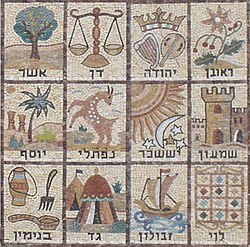
Asher: a tree
Dan: Scales of justice
Judah: Kinnor, cithara and crown, symbolising King David
Reuben: Mandrake (Genesis 30:14)
Joseph: Palm tree and sheaves of wheat, symbolizing his time in Egypt
Naphtali: gazelle (Genesis 49:21)
Issachar: Sun, moon and stars (1 Chronicles 12:32)
Simeon: towers and walls of the city of Shechem
Benjamin: jug, ladle and fork
Gad: tents, symbolizing their itinerancy as cattle-herders
Zebulun: ship, due to their bordering the Sea of Galilee and Mediterranean
Levi: Priestly breastplate, symbolizing the Kohanim
The Twelve Tribes of Israel (Hebrew: שִׁבְטֵי־יִשְׂרָאֵל, romanized: Šīḇṭēy Yīsrāʾēl, lit. 'Staffs of Israel') are, according to Hebrew scriptures, the descendants of the biblical patriarch Jacob (also known as Israel), who collectively form the Israelite nation. The tribes were through his twelve sons through his wives, Leah and Rachel, and his concubines, Bilhah and Zilpah. In modern scholarship, there is skepticism as to whether there ever were twelve Israelite tribes, with the use of the number 12 thought more likely to signify a symbolic tradition as part of a national founding myth,[1] although some scholars disagree with this view.[2]
- ^ Cite error: The named reference
Glassmanwas invoked but never defined (see the help page). - ^ Blum, Erhard (2020). "The Israelite Tribal System: Literary Fiction or Social Reality?". In Krause, Joachim J.; Sergi, Omer; Weingart, Kristin (eds.). Saul, Benjamin, and the Emergence of Monarchy in Israel: Biblical and Archaeological Perspectives. SBL Press. p. 213. ISBN 978-0-88414-451-9.